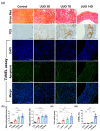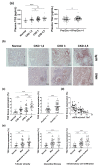Inhibiting Transglutaminase 2 Mediates Kidney Fibrosis via Anti-Apoptosis
- PMID: 35740367
- PMCID: PMC9220123
- DOI: 10.3390/biomedicines10061345
Inhibiting Transglutaminase 2 Mediates Kidney Fibrosis via Anti-Apoptosis
Abstract
Transglutaminase 2 (TG2) is a calcium-dependent transamidating acyltransferase enzyme of the protein-glutamine γ-glutamyltransferase family implicated in kidney injury. In this study, we identified associations between TG2 and chronic kidney disease (CKD) identified by visualizing TG2 in kidney biopsy samples derived from CKD patients using immunohistochemistry and measuring the plasma TG2 concentrations. Our study revealed a connection between TG2 and the pathological markers of kidney disease. We showed high plasma TG2 levels in samples from patients with advanced CKD. In addition, we observed an increase in TG2 expression in tissues concomitant with advanced CKD in human samples. Moreover, we investigated the effect of TG2 inhibition on kidney injury using cystamine, a well-known competitive inhibitor of TG2. TG2 inhibition reduced apoptosis and accumulation of extracellular molecules (ECM) such as fibronectin and pro-inflammatory cytokine IL-8. Collectively, the increased expression of TG2 that was observed in advanced CKD, hence inhibiting TG2 activity, could protect kidney cells from ECM molecule accumulation, apoptosis, and inflammatory responses, thereby preventing kidney fibrosis.
Keywords: apoptosis; chronic kidney disease; cystamine; fibrosis; transglutaminase 2.
Conflict of interest statement
The authors have no conflict of interest to declare.
Figures





Similar articles
-
Transglutaminase 2 as a novel target in chronic kidney disease - Methods, mechanisms and pharmacological inhibition.Pharmacol Ther. 2021 Jun;222:107787. doi: 10.1016/j.pharmthera.2020.107787. Epub 2020 Dec 9. Pharmacol Ther. 2021. PMID: 33307141
-
Inhibition of transglutaminase 2 (TG2) ameliorates ventricular fibrosis in isoproterenol-induced heart failure in rats.Life Sci. 2023 May 15;321:121564. doi: 10.1016/j.lfs.2023.121564. Epub 2023 Mar 15. Life Sci. 2023. PMID: 36931499
-
Tissue transglutaminase exacerbates renal fibrosis via alternative activation of monocyte-derived macrophages.Cell Death Dis. 2023 Mar 2;14(2):136. doi: 10.1038/s41419-023-05622-5. Cell Death Dis. 2023. PMID: 36864028 Free PMC article.
-
Feline chronic kidney disease is associated with upregulation of transglutaminase 2: a collagen cross-linking enzyme.Vet Pathol. 2015 May;52(3):513-23. doi: 10.1177/0300985814542811. Epub 2014 Jul 21. Vet Pathol. 2015. PMID: 25047228
-
Implications of enigmatic transglutaminase 2 (TG2) in cardiac diseases and therapeutic developments.Biochem Pharmacol. 2022 Jul;201:115104. doi: 10.1016/j.bcp.2022.115104. Epub 2022 May 23. Biochem Pharmacol. 2022. PMID: 35617996 Review.
Cited by
-
STAT3 blockade ameliorates LPS-induced kidney injury through macrophage-driven inflammation.Cell Commun Signal. 2024 Oct 4;22(1):476. doi: 10.1186/s12964-024-01841-1. Cell Commun Signal. 2024. PMID: 39367511 Free PMC article.
-
Pathogenetic Contributions and Therapeutic Implications of Transglutaminase 2 in Neurodegenerative Diseases.Int J Mol Sci. 2024 Feb 17;25(4):2364. doi: 10.3390/ijms25042364. Int J Mol Sci. 2024. PMID: 38397040 Free PMC article. Review.
-
Molecular Basis of Transglutaminase-2 and Muscarinic Cholinergic Receptors in Experimental Myopia: A Target for Myopia Treatment.Biomolecules. 2023 Jun 27;13(7):1045. doi: 10.3390/biom13071045. Biomolecules. 2023. PMID: 37509081 Free PMC article.
-
Unveiling the role of transgelin as a prognostic and therapeutic target in kidney fibrosis via a proteomic approach.Exp Mol Med. 2024 Oct;56(10):2296-2308. doi: 10.1038/s12276-024-01319-7. Epub 2024 Oct 7. Exp Mol Med. 2024. PMID: 39375532 Free PMC article.
-
Reduced glomerular and elevated tubulointerstitial transglutaminase pathway and its inhibition in a rat model of renal warm ischemia: implications for feline chronic kidney disease.Front Vet Sci. 2025 Jul 14;12:1520917. doi: 10.3389/fvets.2025.1520917. eCollection 2025. Front Vet Sci. 2025. PMID: 40727272 Free PMC article.
References
Grants and funding
LinkOut - more resources
Full Text Sources

